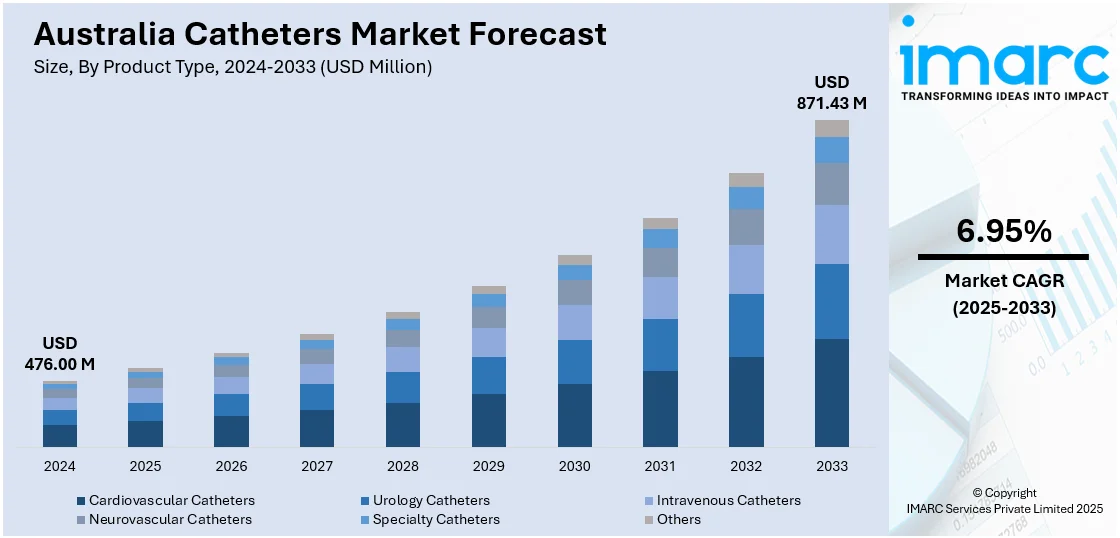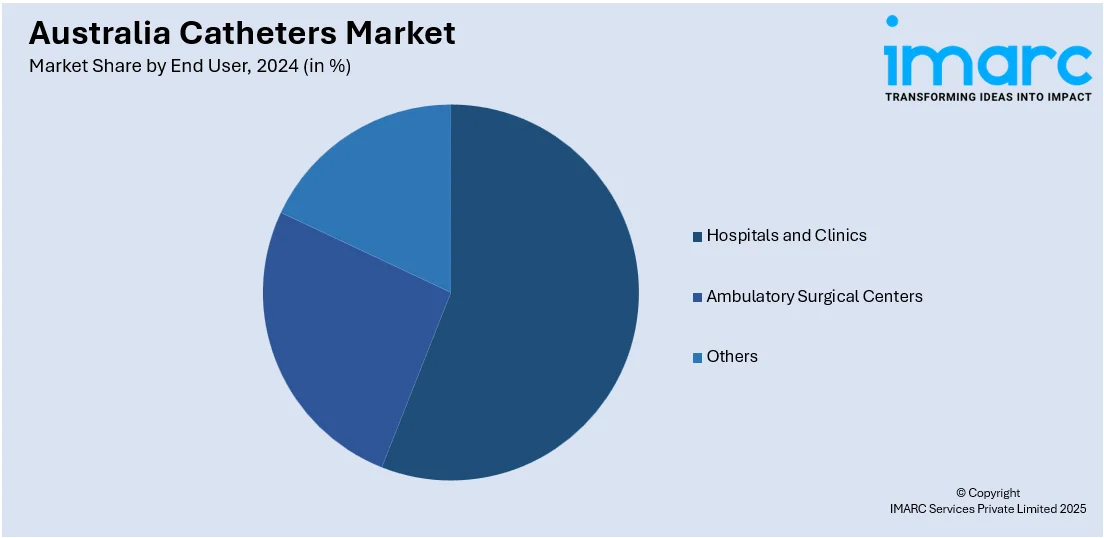
Australia Catheters Market Size, Share, Trends and Forecast by Product Type, End User, and Region, 2025-2033
Australia Catheters Market Overview:
The Australia catheters market size reached USD 476.00 Million in 2024. Looking forward, IMARC Group expects the market to reach USD 871.43 Million by 2033, exhibiting a growth rate (CAGR) of 6.95% during 2025-2033. The market is driven by an aging population, rising chronic diseases like diabetes and kidney disorders, and growing demand for minimally invasive procedures. Increased healthcare spending and hospital infrastructure development, along with technological advancements in catheter materials and design, further enhance adoption, improving patient outcomes and reducing infection risks across various medical settings, thus fueling the Australia catheters market share.
|
Report Attribute
|
Key Statistics
|
|---|---|
|
Base Year
|
2024 |
|
Forecast Years
|
2025-2033
|
|
Historical Years
|
2019-2024
|
| Market Size in 2024 | USD 476.00 Million |
| Market Forecast in 2033 | USD 871.43 Million |
| Market Growth Rate 2025-2033 | 6.95% |
Australia Catheters Market Trends:
Aging Population and Rising Chronic Conditions
Australia’s aging population is a primary driver of the catheter market. As individuals age, they become more susceptible to chronic conditions such as urinary incontinence, cardiovascular diseases, and renal disorders, ailments that often require catheterization. The Australian Institute of Health and Welfare reports a steady increase in the percentage of the population aged 65 and over, which fuels demand for urinary, cardiac, and dialysis catheters. Furthermore, with age-related complications such as prostate enlargement and reduced bladder control becoming more prevalent, the need for intermittent and indwelling catheters continues to grow. This demographic shift significantly influences the healthcare system's emphasis on long-term care and palliative services, both of which often depend heavily on catheter use.

To get more information on this market, Request Sample
Increased Healthcare Infrastructure and Expenditure
Australia’s ongoing investment in healthcare infrastructure directly supports the growth of the catheter market. Government and private sector efforts to expand hospital networks, aged care facilities, and specialized treatment centers lead to increased procurement of essential medical devices, including catheters. According to Australian government health expenditure reports, spending continues to rise annually, with a strong focus on surgical services, diagnostics, and chronic care—all areas that involve catheterization. Additionally, regional expansion of healthcare services ensures wider access to procedures like dialysis and cardiac interventions, especially in underserved communities. The establishment of new day surgeries and rehabilitation centers also creates fresh demand for catheter-related consumables, further propelling the Australia catheters market growth.
Technological Advancements in Catheter Design
Innovations in catheter technology are significantly shaping the Australian market. Modern catheters are now more biocompatible, antimicrobial, and patient-friendly, reducing infection risks and enhancing patient comfort. For instance, the introduction of hydrophilic-coated and antimicrobial catheters minimizes catheter-associated urinary tract infections (CAUTIs), a common healthcare concern. Advancements also include steerable, pressure-sensitive cardiac catheters and high-precision microcatheters used in neurology and oncology. These developments support a shift toward minimally invasive procedures, which are becoming the standard across many Australian healthcare institutions. Moreover, manufacturers emphasize improving catheter flexibility, durability, and ease of insertion. As hospitals and clinics prioritize patient outcomes and procedural efficiency, the demand for next-generation catheter solutions continues to rise steadily.
Australia Catheters Market Segmentation:
IMARC Group provides an analysis of the key trends in each segment of the market, along with forecasts at the country and regional levels for 2025-2033. Our report has categorized the market based on product type and end user.
Product Type Insights:
- Cardiovascular Catheters
- Urology Catheters
- Intravenous Catheters
- Neurovascular Catheters
- Specialty Catheters
- Others
The report has provided a detailed breakup and analysis of the market based on the product type. This includes cardiovascular catheters, urology catheters, intravenous catheters, neurovascular catheters, specialty catheters, and others.
End User Insights:

- Hospitals and Clinics
- Ambulatory Surgical Centers
- Others
A detailed breakup and analysis of the market based on the end users have also been provided in the report. This includes hospitals and clinics, ambulatory surgical centers, and others.
Regional Insights:
- Australia Capital Territory & New South Wales
- Victoria & Tasmania
- Queensland
- Northern Territory & Southern Australia
- Western Australia
The report has also provided a comprehensive analysis of all the major regional markets, which include Australia Capital Territory & New South Wales, Victoria & Tasmania, Queensland, Northern Territory & Southern Australia, and Western Australia.
Competitive Landscape:
The market research report has also provided a comprehensive analysis of the competitive landscape. Competitive analysis such as market structure, key player positioning, top winning strategies, competitive dashboard, and company evaluation quadrant has been covered in the report. Also, detailed profiles of all major companies have been provided.
Australia Catheters Market Report Coverage:
| Report Features | Details |
|---|---|
| Base Year of the Analysis | 2024 |
| Historical Period | 2019-2024 |
| Forecast Period | 2025-2033 |
| Units | Million USD |
| Scope of the Report | Exploration of Historical Trends and Market Outlook, Industry Catalysts and Challenges, Segment-Wise Historical and Future Market Assessment:
|
| Product Types Covered | Cardiovascular Catheters, Urology Catheters, Intravenous Catheters, Neurovascular Catheters, Specialty Catheters, Others |
| End Users Covered | Hospitals and Clinics, Ambulatory Surgical Centers, Others |
| Regions Covered | Australia Capital Territory & New South Wales, Victoria & Tasmania, Queensland, Northern Territory & Southern Australia, Western Australia |
| Customization Scope | 10% Free Customization |
| Post-Sale Analyst Support | 10-12 Weeks |
| Delivery Format | PDF and Excel through Email (We can also provide the editable version of the report in PPT/Word format on special request) |
Key Questions Answered in This Report:
- How has the Australia catheters market performed so far and how will it perform in the coming years?
- What is the breakup of the Australia catheters market on the basis of product type?
- What is the breakup of the Australia catheters market on the basis of end user?
- What is the breakup of the Australia catheters market on the basis of region?
- What are the various stages in the value chain of the Australia catheters market?
- What are the key driving factors and challenges in the Australia catheters market?
- What is the structure of the Australia catheters market and who are the key players?
- What is the degree of competition in the Australia catheters market?
Key Benefits for Stakeholders:
- IMARC’s industry report offers a comprehensive quantitative analysis of various market segments, historical and current market trends, market forecasts, and dynamics of the Australia catheters market from 2019-2033.
- The research report provides the latest information on the market drivers, challenges, and opportunities in the Australia catheters market.
- Porter's five forces analysis assist stakeholders in assessing the impact of new entrants, competitive rivalry, supplier power, buyer power, and the threat of substitution. It helps stakeholders to analyze the level of competition within the Australia catheters industry and its attractiveness.
- Competitive landscape allows stakeholders to understand their competitive environment and provides an insight into the current positions of key players in the market.
Need more help?
- Speak to our experienced analysts for insights on the current market scenarios.
- Include additional segments and countries to customize the report as per your requirement.
- Gain an unparalleled competitive advantage in your domain by understanding how to utilize the report and positively impacting your operations and revenue.
- For further assistance, please connect with our analysts.
 Request Customization
Request Customization
 Speak to an Analyst
Speak to an Analyst
 Request Brochure
Request Brochure
 Inquire Before Buying
Inquire Before Buying




.webp)




.webp)












